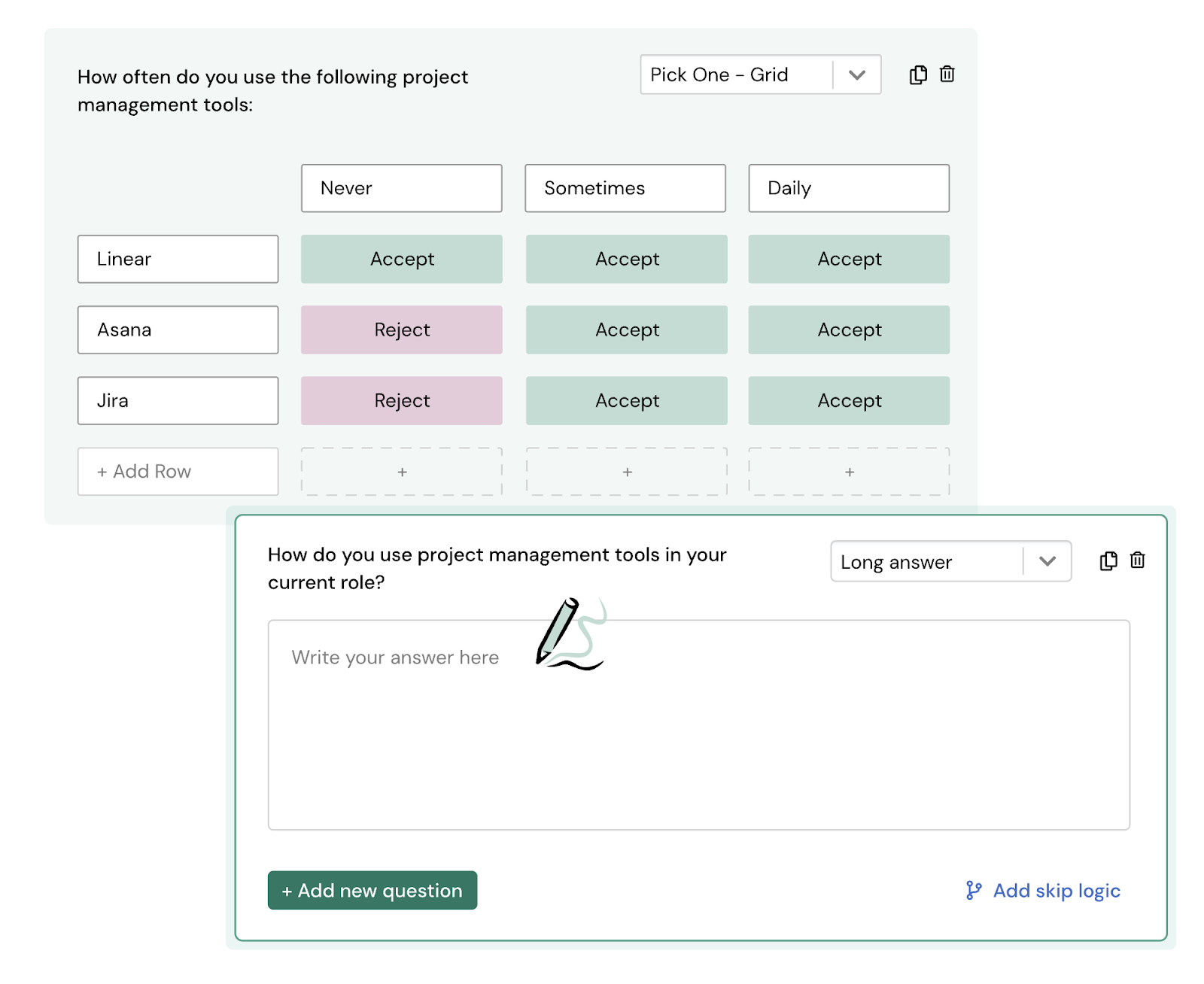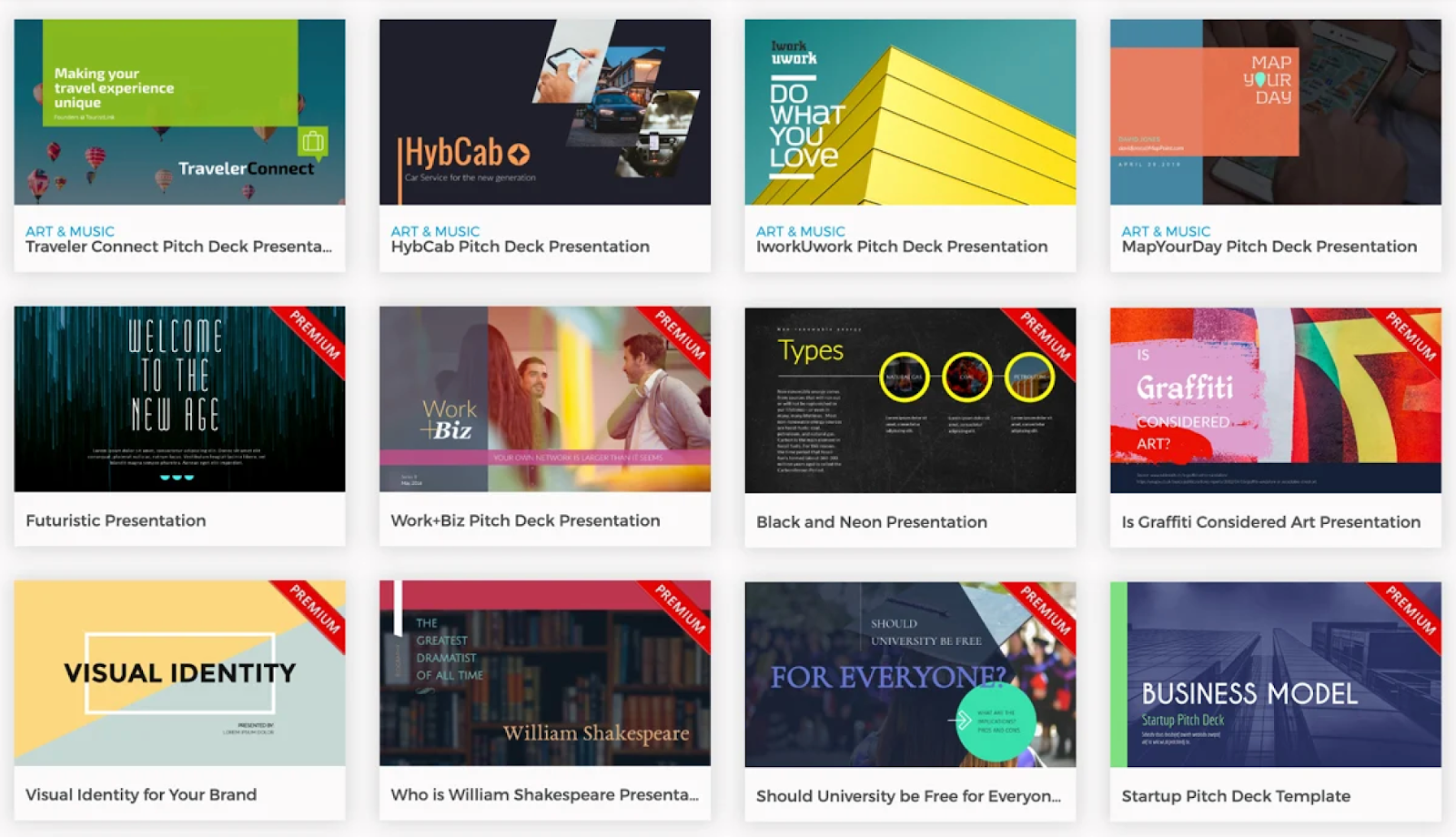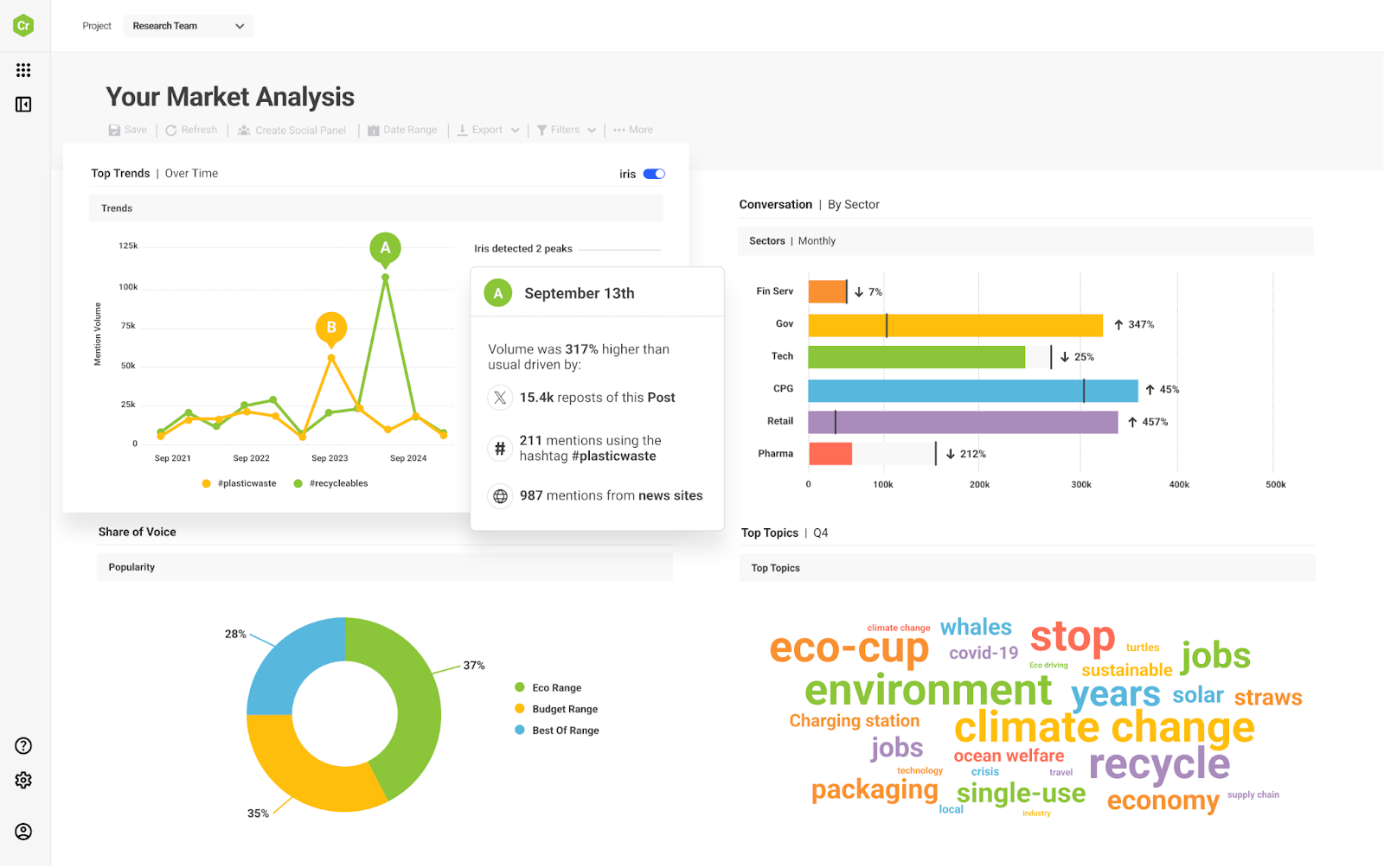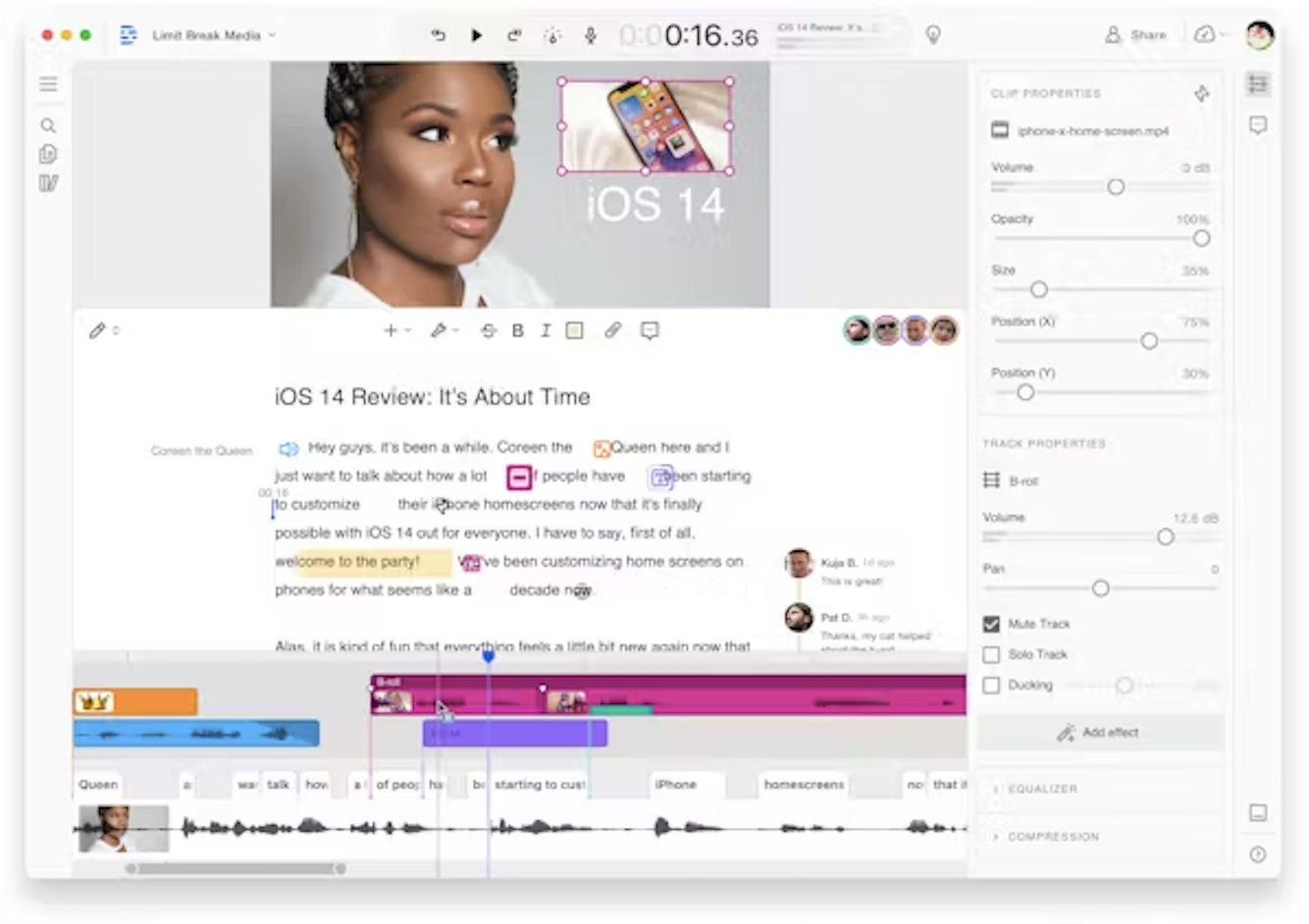August 19, 2025
August 19, 2025
7 Market Research Tools & How to Use Them (2025)

By
Liz White

Are you being asked to DIY your research? Build smarter toolkits? Do more with the same budget?
The market research landscape is rapidly changing, and insights professionals need to evolve their approach to keep up. Teams need faster insights, tighter budgets require creative solutions, and competitive pressures mean you can’t afford to get research wrong.
So what are the top tools that the modern insights professional should have in their stack?
Emerging AI tools are now streamlining and automating research tasks, enabling faster and more accurate insights than ever before.
In this article, we’ll explore seven essential market research tools that help business professionals deliver strategic insights efficiently, whether you’re building capabilities from scratch or optimizing existing workflows.

The Modern Market Research Tool Landscape
The market research industry has transformed dramatically over the past few years.
Doing market research used to require lengthy timelines and large budgets. Today, there are a range of tools available that make it possible to get professional-level market insights in your team’s hands, at a budget and timeline that fits your needs.
These tools fall into categories like:
- Qualitative insights platforms
- Quantitative survey solutions
- AI-powered competitive intelligence
- Social listening
- Presentation tools
Some solutions are offered as an all-in-one platform. Others integrate with multiple market research tools, so you can build a single system with streamlined workflow right-sized for your team. The best research programs will leverage multiple tools to answer different research questions.
7 Essential Market Research Tools
The seven tools we’ve curated below represent a new generation of tools that equip you with everything you need to complete your market research.
These platforms excel at simplifying what were once complex research tasks. They cover everything from expert-moderated qualitative research solutions, to real-time trend analysis, with built-in project management and integrations to streamline your workflow:
- Studio
- Express
- User interviews
- Perplexity
- Beautiful.AI
- Brandwatch
- Descript
Let’s explore each one below.
1. Studio - Qualitative Research Excellence
When you need to understand the ‘why’ behind consumer behavior, Studio transforms how you can access expert-led qualitative research.

Studio is the first end-to-end qualitative research marketplace, designed to eliminate the traditional barriers that make running high-quality qualitative research slow, expensive, and unpredictable. The platform enables teams to conduct deep market research by providing access to expert-led qualitative studies that gather insights on customer needs, market demand, and the competitive landscape.
How it helps:
The platform solves three critical problems that plague traditional qualitative research: finding the right expert moderators for your project and category, the scattered nature of managing your project across multiple platforms and communication channels, and waiting 4-6 weeks for qualitative insights that the business needs now. With Studio, research teams compress timelines from weeks to days, with direct access to a diverse network of vetted and skilled moderators and strategists, best-in-class fieldwork and recruiting partners, and workflow tools that streamline the qualitative process and enable you to work seamlessly together; all in one place.
Features:
The platform handles everything from moderator matching to project management, and integrates seamlessly with top fieldwork tools like Discuss.io and Recollective. Studio’s vetted moderator marketplace makes sure you’re working with professionals who have a proven expertise in your category, so you can avoid poor-quality insights from inexperienced moderators.
Best for:
- Deep foundational understanding, consumer feedback to inform and optimize, drivers of current attitudes, perceptions, and behaviors.
- Building scalable qualitative research programs as an alternative or augment to DIY
- Accessing specialized moderators for niche audiences or complex research methodologies
- Conducting targeted surveys to gather specific audience insights
Ready to transform your approach to qualitative research?
Studio’s vetted moderator marketplace and integrated fieldwork and recruiting tools make running expert-moderated studies simple and seamless.
Discover how leading brands accelerate insights with Studio →
2. Express - Quantitative Research Foundation
When you need robust data to validate hypotheses and measure market opportunities, Express provides the quantitative backbone for data-driven decisions. Informed by 25 years of research best practices, Express provides teams with the ability to create, launch, and analyze surveys in hours.

Express, developed by the same team behind Studio (buzzback), specializes in quantitative market research that delivers global, scalable insights for strategic business decisions.
How it helps: Express removes the complexity of quantitative research by providing teams with turnkey survey templates that include some of buzzback’s projective and enabling techniques that are grounded in behavioral science and psychology to go deeper. Leveraging advanced analytics like Max Diff and TURF, Express enables research teams to quickly test and learn and make informed decisions based on reliable survey data points. Research teams can validate product concepts, size market opportunities, and measure brand performance with statistical confidence quickly and easily.
Features: The platform excels at surveys, polls, and structured data collection with sophisticated branching logic, global reach, and automated analysis capabilities. Its templates for testing Concepts, Claims, Names, Packages, Flavors/Variants, and Brand Perceptions leverage best practices and its real-time dashboards and one-click reports make survey reporting simple and easy.
Best for:
- Market sizing and opportunity assessment with statistical confidence
- Product concept testing and validation across large sample sizes
- Brand tracking and competitive benchmarking with quantitative precision
- Supporting data driven decision making for marketing and product teams
3. User Interviews - Research Participant Recruitment
When your research quality depends on reaching the right participants, User Interviews provides the recruitment infrastructure that powers successful studies across a range of methodologies.

User Interviews offers a comprehensive participant recruitment platform for the market research industry, connecting researchers with over 4 million pre-screened participants across diverse demographics and professional backgrounds.
How it helps: A market research analyst can leverage User Interviews to efficiently gather real-time insights and analyze trends by connecting with the right participants. Teams can recruit specialized audiences, including potential customers, in a matter of days. Their advanced fraud detection protocols ensure participant quality which directly impacts research reliability. Recruiting the right participants leads to more valuable data for research projects, supporting better decision-making and insights.
Features: The platform streamlines everything from participant sourcing to scheduling and compensation management, with rigorous screening processes and participant verification that ensure authentic target audience representation rather than professional survey takers. The platform is useful both for small businesses and large enterprises looking to conduct research.
Best for:
- Recruiting specialized audiences that are slow and difficult to find through traditional methods
- Managing complex scheduling for multi-session research studies
- Ensuring participant authenticity and engagement for high-stakes research projects
4. Perplexity - AI-Powered Market Intelligence
When you need comprehensive secondary research and market context to inform your primary research, Perplexity transforms how businesses gather competitive intelligence and industry insights by acting as a business intelligence tool that turns data into actionable insights.

Perplexity functions like having a dedicated research analyst for secondary research. It excels at gathering information from hundreds of sources in minutes to provide comprehensive market context and competitive intelligence, including the analysis of unstructured data from diverse online sources.
How it helps: Perplexity enhances primary research efforts by serving up essential context and background intelligence to inform your design studies, or even to help you analyze findings after the fact. Research teams use it to understand competitive landscapes, identify emerging trends in the market, and gather strategic context that informs better research questions and helps interpret primary research results more effectively.
Features: The platform uses AI capabilities to search real-time web data. You can have it analyze competitive positioning, track industry developments, or provide comprehensive answers to complex market questions while citing reliable sources for verification and deeper exploration. As an addition to your business intelligence stack, Perplexity can also extract insights from unstructured data like social media and websites.
Best for:
- Secondary research to inform primary research design and question development
- Competitive analysis and market landscape mapping as context for consumer studies
- Gathering industry trends and market intelligence to complement first-party insights
- Gathering industry trends and market intelligence to complement first-party insights
5. Beautiful.AI - AI-Powered Presentations & Storytelling
When you need to transform research insights into compelling presentations that drive action, this tool's AI-powered presentation maker makes it easy to present your data visually.

How it helps: Beautiful.AI eliminates the insights presentation bottleneck that often prevents research from driving meaningful action. Research teams can quickly transform findings into executive-ready presentations with professional design and clear narrative flow, making sure insights get the attention they deserve in boardrooms and strategy sessions.
Features: The platform uses AI to assist with design, content organization, and narrative structure. Feed in your research findings, and organize them into presentations that communicate effectively with smart templates and automated design suggestions. Beautiful.AI can visualize data from multiple data sources, helping you build comprehensive presentations fast.
Best for:
- Creating executive-ready presentations from complex research data
- Building compelling client reports that drive business decisions
- Streamlining the journey from insights to organizational action
- Presenting trends shaping the industry or market
6. Brandwatch - Social Listening & Brand Monitoring
When you need to monitor what consumers are really saying about your brand and industry, Brandwatch offers comprehensive social intelligence that reveals unfiltered market sentiment.
One of the leading monitoring tools for online brand reputation, Brandwatch excels at social media monitoring to track and analyze brand mentions and audience engagement across any social media channel. It also analyzes social media usage trends to deliver valuable insights into audience behavior and preferences.

How it helps: Brandwatch helps solve the insights gap that occurs when brands rely too heavily on surveys, and structured research. It monitors millions of online conversations, giving teams access to authentic, unsolicited consumer sentiment. Their AI is capable of identifying patterns humans might miss in social conversations, enabling research teams to detect potential crises before they escalate, identify emerging consumer trends, and track competitive activities as they happen in real-time across digital channels.
Features: The platform has advanced sentiment analysis and trend identification capabilities, providing comprehensive social intelligence for reputation management, competitive monitoring, and consumer trend analysis. Track brand mentions and sentiment across any social media channel, while also leveraging data on social media usage to better understand target audiences. Brandwatch can also complement public opinion polling by providing real-time social data, offering a broader perspective on societal issues and trends alongside traditional research methods.
Best for:
- Real-time brand reputation monitoring and crisis detection
- Competitive intelligence and market trend identification
- Understanding authentic consumer sentiment beyond survey responses
7. Descript - Research Asset Creation & Video Editing
When you need to harness the power of authentic voice of the customer videos to motivate business action, Descript helps you transform raw research footage into compelling assets for stakeholders and decision-makers across the business.

Descript simplifies the process of creating impactful voice of the customer content from video interviews, focus group sessions, and consumer testimonials using AI-powered editing tools.
How it helps: Descript unlocks the persuasive power of authentic consumer voices, helping you transform hours of research footage into polished highlight reels that motivate stakeholders and drive business decisions. Research teams can extract the most compelling customer moments, create powerful testimonial libraries, and produce shareable assets that bring consumer insights to life for executives who weren’t present during data collection.
Features: The platform combines AI transcription with intuitive editing tools that let research teams create professional-quality video content. You can create libraries of consumer testimonials, build up evidence to inform strategic recommendations, and even create web pages to share the videos and findings online. Descript also offers a free tool option for basic video editing and research asset creation, making it accessible for those seeking cost-effective solutions.
Best for:
- Creating powerful voice of the customer highlight reels from qualitative research sessions
- Building libraries of authentic consumer testimonials that motivate business action
- Transforming research outputs into compelling stakeholder communications that drive decisions
- Supporting online business owners in sharing research findings and insights through video content

Essential Tips for Conducting Effective Market Research
Getting the right market research tools in place is only half the battle. Leveraging multiple data sources—including structured and unstructured, private and public, and global data inputs—is essential for comprehensive research. How you use these tools determines whether your research drives business impact or just creates more data to sort through.
By following these tips, market researchers can maximize the value of their research tools and ensure their insights lead to actionable business decisions.
1. Start with Clear Research Objectives
Before getting started with any market research tool, define exactly what business decision your research needs to inform.
Are you validating a product concept? Understanding why customers churn? Identifying new market opportunities? Your research objectives should be specific enough that you'll know exactly what data you need and how you'll use the insights.
Clear objectives help you choose the right research methodology and tools for each question. If you need to understand customer emotions and motivations, qualitative research through platforms like Studio will provide deeper insights than survey data alone. If you need to quantify market opportunity, Express or other quantitative tools become key.
2. Choose Methodologies That Match Your Research Questions
Different business questions require different research approaches.
Quantitative methods excel at measuring what and how much, while qualitative methods reveal why and how. Social listening tools like Brandwatch capture authentic, unprompted consumer sentiment, while surveys gather structured feedback on specific topics.
The most effective market research combines inputs from a range of sources, using multiple methodologies. Use quantitative research to establish statistical significance and qualitative research to understand the human story behind the numbers. AI-powered tools like Perplexity can provide market context that helps interpret findings from primary research.
3. Ensure Representative Sample Sizes
Sample quality matters more than sample size, but both impact research reliability.
When recruiting participants through platforms like User Interviews, focus on finding people who genuinely represent your target audience rather than just hitting arbitrary numbers.
For quantitative research, ensure your sample size provides statistical confidence for the decisions you need to make. For qualitative research, prioritize participant diversity and category relevance over large numbers. A well-moderated focus group with eight relevant participants often provides more actionable insights than fifty survey responses from the wrong audience.
4. Integrate Qualitative and Quantitative Approaches
The best market research combines the statistical power of quantitative data with the contextual depth of qualitative insights.
Use quantitative research to measure the scale of opportunities and qualitative research to understand the human factors that drive those numbers.
This integrated approach helps avoid the trap of making strategic decisions based on incomplete information. Numbers tell you what's happening, but qualitative insights reveal why it's happening and what you can do about it.
5. Plan for Actionable Insights from Day One
Design your research process to produce insights that directly inform business decisions.
This means involving stakeholders in research planning, choosing methodologies that answer specific business questions, and presenting findings in formats that enable immediate action.
Consider how you'll use insights before you collect them. If research findings won't change how your business operates, question whether the research is worth conducting.
How Market Research Tools Unlock Consumer Insights
Whether you’re a small business owner or part of a large marketing team, leveraging the right research tools can unlock valuable consumer insights and give you a competitive edge. Market research tools come in many forms, each designed to help businesses collect, analyze, and visualize data about your target market.
Free market research tools like Google Trends offer a window into real-time search trends and shifting consumer interests, making them a great starting point for businesses on a budget.
Demographic research is also essential for understanding the makeup of your target market. Platforms like Express, enable detailed insights for quantitative requirements in your research, helping you tailor strategies to specific geographic locations or segments.
Focus groups and online surveys, facilitated by platforms like Studio, provide face to face insights from potential customers, revealing preferences, pain points, and motivations.
Social media monitoring tools like Brandwatch expand your market intelligence by giving you the ability to track brand mentions, sentiment, and engagement across digital channels.
In Summary
The tools we’ve covered offer a complete ecosystem for gathering, analyzing, and acting on market insights that drive business growth.
Success in market research comes from asking better questions, not just collecting more data. Analyzing billions of data points from various sources leads to more accurate market insights, trend prediction, and competitive benchmarking. The businesses that thrive in competitive markets are those that understand their consumers deeply and act on insights quickly. Your research tool stack should enable both understanding and action.
Ready to revolutionize your approach to qualitative research?
Studio’s marketplace of expert moderators and integrated project management eliminates the complexity of running professional qualitative studies. Book a demo to explore how Studio can accelerate your research timeline while ensuring expert-quality insights →
Frequently Asked Questions
What is Market Research?
Market research is the cornerstone of smart decision-making. It’s the process of gathering, analyzing, and interpreting market research data to understand your target market, spot market trends, and decode consumer behavior.
When you leverage a variety of research tools and methodologies, You have a better chance at uncovering valuable insights into what customers want, how they think, and where opportunities lie.
Whether you’re launching a new product, entering a new market, or refining your marketing strategy, market research platforms provide the resources and data analysis capabilities needed to move fast in the right direction.
What are the best tools for market research?
The best market research tools depend on your specific research objectives and business needs. For comprehensive market research, you'll typically need a combination of qualitative and quantitative tools. Studio excels at qualitative research with expert moderators, while Express handles quantitative surveys and data analysis. User Interviews provides participant recruitment, and Brandwatch monitors social sentiment. The most effective approach combines multiple tools that complement each other rather than relying on a single platform.
For businesses just starting their research journey, begin with foundational tools like Studio for qualitative insights and Express for quantitative validation. As your research program matures, add specialized tools for social listening, competitive analysis, and presentation creation.
Is Google Analytics a market research tool?
Google Analytics provides valuable market insights, but it's primarily a web analytics platform rather than a dedicated market research tool. Google Analytics excels at showing you how visitors interact with your website, which pages they visit, and how they move through your conversion funnel.
For market research purposes, Google Analytics data becomes most valuable when combined with other research methods. Web analytics can reveal user behavior patterns, but they don't explain the motivations behind those behaviors. Combine Google Analytics insights with qualitative research through platforms like Studio to understand why users behave certain ways on your site.
Google Analytics works well as part of a broader market research approach, particularly when integrated with social listening tools like Brandwatch and competitive analysis platforms like Perplexity. The combination provides a more complete picture of market dynamics than any single tool alone.
What are the best methods for market research?
The best market research methods combine qualitative and quantitative approaches to provide both statistical significance and human context. Quantitative methods like surveys and analytics provide measurable data about market size, consumer preferences, and behavioral patterns. Qualitative methods like focus groups and in-depth interviews reveal the motivations, emotions, and decision-making processes behind those patterns.
Modern market research increasingly relies on mixed-method approaches. Start with qualitative research to understand consumer motivations and identify key themes, then use quantitative research to measure how widely those themes apply across your target market. Social listening through tools like Brandwatch captures authentic consumer sentiment, while AI-powered platforms like Perplexity provide competitive context.
The most effective market research methods are those that directly inform business decisions. Choose methodologies based on the specific questions you need to answer rather than defaulting to familiar approaches. If you need to understand why customers churn, qualitative research through Studio will provide deeper insights than survey data alone.
How do I integrate multiple market research tools?
Successful tool integration starts with defining clear workflows that connect insights across platforms. Begin by mapping your research process from initial questions through final recommendations, then identify which tools handle each stage most effectively.
Most modern market research tools offer API integrations or export capabilities that enable data sharing between platforms. Plan your tool stack to minimize manual data transfer and ensure insights flow smoothly from collection through analysis to presentation.
Consider platforms that are designed to work together. Studio integrates directly with User Interviews for participant recruitment and with presentation tools for insight communication. This reduces the technical complexity of managing multiple vendors while ensuring consistent data quality throughout your research process.
What's the difference between qualitative and quantitative research tools?
Qualitative research tools like Studio focus on understanding consumer motivations, emotions, and decision-making processes through methods like focus groups, in-depth interviews, and ethnographic studies. These tools excel at revealing the 'why' behind consumer behavior and provide rich, contextual insights that explain market dynamics.
Quantitative research tools like Express specialize in measuring and counting consumer behaviors, preferences, and market characteristics through surveys, polls, and statistical analysis. These tools provide the numerical foundation for business decisions and enable confident market sizing and trend measurement.
The most effective market research programs use both types of tools strategically. Qualitative research helps identify the right questions to ask and provides context for interpreting quantitative findings. Quantitative research validates qualitative insights across larger populations and provides the statistical confidence needed for major business decisions.
Subscribe
Stay up to date on industry insights and resources from Studio.

